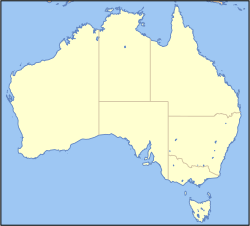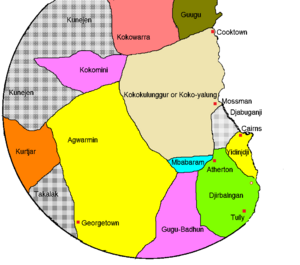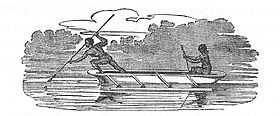Guugu Yimithirr people facts for kids
|
Location of the Guugu Yimithirr people |
The Guugu Yimithirr are an Aboriginal Australian people. They live in Far North Queensland, Australia. Many Guugu Yimithirr people today live in a place called Hopevale. This town is the main center for the Hopevale Shire.
In 2011, about 1,005 people lived in Hopevale. It is about 46 kilometers (29 miles) from Cooktown. The name "Guugu Yimithirr" also refers to their language. These people lived both near the coast and further inland. Those near the coast called themselves "saltwater people."
Contents
The Guugu Yimithirr Language
The Guugu Yimithirr language means 'language/speaking this way'. It was one of the first Australian languages ever written down. This happened when Sydney Parkinson recorded about 200 words in 1770. He was with Captain Cook during Cook's visit to the area.
The language has different ways of speaking, called dialects. Dhalun-dhirr was spoken by people near the coast. Waguurr-ga was spoken by people living inland. Today, about 200 people still speak Guugu Yimithirr. A linguist named Peter Austin said it is at risk of disappearing.
Guugu Yimithirr people often knew several languages. This was because they married people from other tribes who spoke different tongues.
Special Ways of Speaking
The Guugu Yimithirr language has a special way of speaking called avoidance speech. This means you must use different words when certain family members are nearby. For example, a man would use special words if his father-in-law or brother-in-law was present.
Normally, to say 'the man is going', you would say bama dhaday. But with certain relatives, you would say yambaal bali. It was even forbidden to speak at all in front of one's mother-in-law. You had to sit silently with your head bowed.
Understanding Directions
The Guugu Yimithirr language uses a very different way to describe directions than English. In English, we say "left," "right," "front," or "behind." These directions depend on where you are facing.
But in Guugu Yimithirr, directions are always given using the main compass points: north, south, east, and west. This is true no matter which way a person is facing. For example, if you left something on a table, you might say, "I left it on the southern table in the western side of your house." This helps them know exactly where things are, like having a mental map.
Guugu Yimithirr Traditional Lands
The Guugu Yimithirr people's traditional lands stretched from the Endeavour River. They went north to the mouth of the Starcke River. According to Norman Tindale, their land reached near Cape Flattery in the north.
To the west, their territory reached the source of the Jack River. To the south, it went to Battle Camp, which is north-west of Cooktown. Their land covered about 600 square miles (1,550 square kilometers).
Captain Cook left some pigs on the land. These pigs bred quickly and became an important food source for the local people.
Early Contact with Europeans
On June 11, 1770, Lieutenant James Cook arrived at the mouth of the Endeavour River. This is where modern Cooktown is today. His ship, the HM Bark Endeavour, was damaged on a reef. Cook and his crew stayed for seven weeks to fix the ship.
This area was the traditional land of the Guugu Yimithirr people. At first, the Guugu Yimithirr kept their distance. But after a month, five men approached the Europeans. They started a friendly relationship and were shown the Endeavour ship.
A Clash of Cultures
The next day, things became difficult. The Guugu Yimithirr visited the Endeavour and saw a catch of local turtles. They expected to share the food, as was their custom. However, Cook needed to feed his own crew and refused to share the turtles. He offered them bread, which they did not like.
This showed different ideas about hospitality and sharing. Soon after, the local people set fire to grass in the bay. In response, some people were hurt by shots fired by the Europeans.
Joseph Banks's artist, Sydney Parkinson, drew sketches of the local people. He wrote in his journal that they were small and agile. They painted their skin with red and white ochre. They also shaved their hair and pierced their noses. Women wore feather headdresses. They used wood to sharpen their spears, which had bone tips. Parkinson noted that their language sounded clear and pleasant.
History of Settlement and Challenges
The Aboriginal tribes around Cooktown faced many challenges. The Guugu Yimithirr people were greatly affected. They experienced large-scale killings, and women and children were taken away.
For example, on February 20, 1879, 28 Aboriginal men were shot and drowned at Cape Bedford. Police officers and their troopers trapped a group of 28 Guugu Yimithirr men and 13 women. None of the men escaped. Many were shot on the beach, and others swam into the sea and were never seen again.
In 1885, a rule was made that stopped Aboriginal people from moving around after dark. In the same year, a Lutheran missionary named Johann Flierl started a mission. It was called the Elim Aboriginal Mission near Cape Bedford.
The next year, G. H. Schwartz took over the mission. He renamed it Hope Vale. Schwartz stayed with his community until World War II. During the war, the people were moved inland from Rockhampton. Schwartz had learned the Guugu Yimithirr language very well. This helped keep their traditional knowledge alive. However, he was considered an "enemy alien" and was held by the government. The colder climate where they were moved caused many people to get sick and die.
The Story of the Word "Kangaroo"
On June 24, 1770, Captain Cook saw an animal he described as: "of a light mouse Colour and the full size of a Grey Hound, and shaped in every respect like one, with a long tail, which it carried like a Grey hound; in short, I should have taken it for a wild dog but for its walking or running, in which it jumpd like a Hare or Deer."
Joseph Banks wrote in his journal that the local people called this animal a "Kangooroo." After Europeans settled, they started calling the animal by this name.
However, when Captain Phillip King visited the same coast in 1820, he asked about the animal. He was told it was called minnar or meenuah. This led to a popular story that "kangaroo" actually meant "I don't know" in the local language.
Later, an American expert named John Haviland studied the Guugu Yimithirr language. He found that a word like gangurru did exist. This word referred to the large grey kangaroo, which was not very common near the coast. The word King heard, minha, was close to their word for meat or edible animal. So, Captain Cook's original report was correct!
Other Names for Guugu Yimithirr
- ?Boolcanara.
- Gogo-Yimidjir
- Gug-Imudji
- Jimidir
- Kokojimidir
- Kokojimoji. (southern pronunciation)
- Kokoyimidir.(northern pronunciation)
- Kookcymma (typo)
- Kookoyuma
Some Guugu Yimithirr Words
- dhawuunh: 'friend'
- Ngayu mayi buda-nhu: 'I'm hungry' (literally 'I want to eat food').
- (In front of one's brother-in-law, one would say: Ngayu gudhubay bambanga-nhu.)
See also
 In Spanish: Guugu Yimithirr para niños
In Spanish: Guugu Yimithirr para niños




